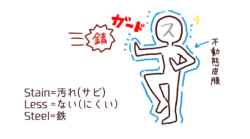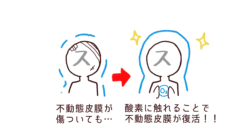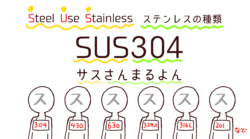It’s a little late for this, but!
This is the second in a series of articles.
What is “stainless steel” anyway?
In English, stainless steel is called “stainless steel.
The word “stainless” means “rustproof”. (Strictly speaking, it is rust-resistant.)
Stainless steel is 100% recyclable, making it an environmentally friendly metal.
The characteristics of stainless steel
Stainless steel is an alloy made of iron (more than 50%) and chromium (more than 10.5%).
Stainless steel is an alloy that is extremely resistant to rust.
(*The more chromium is added to iron, the more rust resistant it becomes.
In addition to corrosion resistance, the alloy has excellent properties such as heat resistance, workability, and strength.
In addition to corrosion resistance, it has excellent properties such as heat resistance, workability, and strength. It also has excellent design and is easy to maintain.

Why is it resistant to rust?
The surface of stainless steel is covered with a very thin film called a passive film (*), which prevents rust from progressing.
The passive film is formed by the combination of chromium and oxygen.
The passive film is as thin as 3 nanometers (3 mm per million!). The passive film is very thin, about 3 nanometers.
Although the passive film is very thin (about 3 nanometers), it is very tough, and even if the film is damaged by scratches, it can be automatically regenerated if there is oxygen around it.

What is the meaning of SUS304 and SUS430 that we often see?
There are more than 100 types of stainless steel.
SUS304 and SUS430 are one of the many types of stainless steel.
SUS is an acronym for “Steel Use Stainless”, which is written in English.
It can be read as “SUS San Maru Yon” or “SUS Yon San Maru”.
The number after it indicates the type of stainless steel.
Depending on the type, it is classified as 200 series, 300 series, 400 series, 600 series…etc.
SUS304 is used all over the world, and is a representative of the 300 series, and also a representative of all types of stainless steel.

